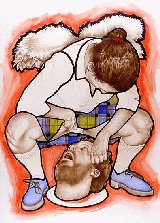5. The Body in Art and Philosophy
While genius is a rare gift, according to most theorists the pool of human beings from which genius emerges includes only men. Rousseau, Kant, and Schopenhauer all declared that women possess characters and mentalities too weak to produce genius. This judgment represents a particular instance of more general theories that attribute to males the strongest and most important qualities of mind, in comparison to which females are but paler counterparts. At least since Aristotle, rationality and incisive intellect have been regarded as “masculine” traits that women possess in lesser degrees than males. Females are standardly considered less intellectual but more sensitive and emotional. According to some theories of creativity, this emotionality and sensitivity can be inspirational virtues, and so the field of aesthetics has been more responsive to the positive uses to which these traits might be put than are some other areas of philosophy. When it comes to genius, however, male artists get the best of both worlds: the great artistic genius is more than intellectually brilliant; he is also emotionally sensitive and fine-tuned, thus possessing characteristics that are traditionally labeled both “masculine” and “feminine.”
Christine Battersby has detailed the long and complicated history of the concept of genius, which has roots in antiquity (Battersby 1989). By the time it reaches its powerful Romantic form in the eighteenth and nineteenth centuries, it is especially exclusionary of women artists. The artistic genius was praised not only for the strong mentality that has always been attributed more heavily to men than to women, but also for a sensitivity and creativity that partakes equally of supposedly feminine attributes. Especially in the nineteenth century, such “nonrational” sources of inspiration were extolled for transcending the rules of reason and bringing something new into being. Womanly metaphors of conception, gestation, labor, and birth were liberally appropriated in descriptions of artistic creativity, at the same time that actual women artists were passed over as representatives of the highest aesthetic production.
As the nineteenth century drew on … the metaphors of male motherhood became commonplace — as did those of male midwifery. The artist conceived, was pregnant, laboured (in sweat and pain), was delivered, and (in an uncontrolled ecstasy of agonized — male — control) brought forth. These were the images of ‘natural’ childbirth that the male creators elaborated. (Battersby 1989: 73).

The description of genius with feminine images did not serve to bridge the gulf between male and female artists, partly because of the different ways that their creativity was conceived. Actual childbirth was regarded as an outgrowth of women's “natural” biological role; their own particular emotions and sensitivities were similarly regarded as manifestations of what nature bestowed upon them. Their artistic expression was thereby categorized as less achievement than natural display; consequently the expression of feeling in women's art was often seen as a manifestation of temperament, while strong feelings expressed in the work of men were interpreted as emotion conveyed with mastery and control. Emotions in women's art were seen as a byproduct of nature; in contrast, the genius of the male artist produces a new creation that transcends the dictates of nature (Korsmeyer, 2004: ch.3).
While by and large disparate evaluations of the capabilities and social roles of men and women have inhibited women's historical accomplishments in the fine arts, they have not prevented them entirely. Art and music historians have reevaluated the record of fine art and brought a number of women practitioners to the attention of the art public and scholarship alike, for while there have been relatively few “great” women artists, they have not been altogether absent from the historical record. What is more, there are certain art forms in which women were the pioneers, such as the prose novel. The novel is a relatively new art form in the west, and it began as a popular art form whose market demand also afforded opportunities for women writers to earn money. Their works were not always accorded the highest acclaim, for there was a lot of critical disdain for the popularity of their stories. Some of them, however, such as George Eliot and Charlotte Brontë, created works of lasting acclaim and value, and even earned that contested accolade, “genius.”

At the same time, a general skepticism about the soundness of the canon of great arts of the past has informed a good deal of feminist scholarship in the critical disciplines, which has reassessed the historical record in painting, music, sculpture, and literature and revised the canon to include neglected works by women. Rediscovery of the work of women of the past was one of the major efforts of feminist scholars during second-wave feminism, a period that also saw the founding of women's studies programs at many colleges and universities in North America and Europe. Especially in the early years of such studies, the main goal of scholarship was to give women a fair shot at recognition in order to attain the goal of sexual equality in the arts. As we shall see shortly, this proved to be a temporary objective, one stage in the development of work in feminist aesthetics.
There has been considerable debate among feminist scholars concerning how to assess the values associated with genius and artistic accomplishment. Some have argued that the idea of genius is cast into suspicion because of the great disparities in education available to people and ought to be discarded. In addition, valorizing the accomplishments of one individual perpetuates the neglect of joint and communal creativity in favor of a kind of masculine heroism. (In fact, feminist art of the 1970s was often collaborative, an explicit rejection of the idea of individual creativity in favor of joint efforts among women.) Other feminists disagree and have located alternative criteria at work in women's achievements, arguing that one can discern traditions of female genius at work in the body of art produced by women (Battersby, 1989). This debate is a particular entry into broader discussions over whether women's art might represent a kind of “feminine” tradition of creativity (Ecker, 1986; Hein and Korsmeyer, 1993, sect. II). If this is to mean that the works of women artists always manifest certain feminine aesthetic qualities because their makers are females, then the majority of feminists answer in the negative, recognizing that other social positions (historical, national, and so forth) impose too many differences on women to yield any feminine common denominator to their work (Felski, 1989, 1998). On the other hand, some scholars argue that women artists and writers often produce a counter-voice within their ambient traditions which might be considered to claim its own “aesthetic.” Where one stands in this debate depends much on the scope of evidence considered relevant to the question (Devereaux, 1998). Claims for a tradition of feminine aesthetics have been widely criticized for essentializing women and ignoring their many social and historical differences. On the other hand, as Cornelia Klinger observes, in retrospect speculations about a women's art tradition seem more sophisticated than the label “essentialism” implies, because they move beyond egalitarian liberalism and recognize the enduring influences of gender in aesthetic productions (Klinger, 1998, p. 350).





